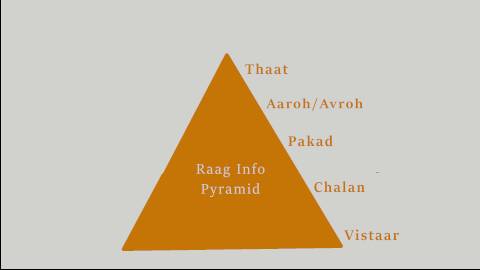5 Ways to describe a raga or raag?
Raga or Raag is a framework created out of surs or swaras. Each raga is said to affect an emotion in the minds of listeners. Each raga has a unique set of sequence of notations (sur) which characterizes that particular raga.
Raga is a loose framework as such in the sense that it can be sung in as many variations as possible as long as the basic rules of layout of surs in that raga are followed.
A singer can thus embellish a raga in a variety of ways by adding other notations (sur) while maintaining the core notational framework of raga.
This also means that a Raga can take various forms and it is really upto singer to use his imagination and experience in embellishing the raga with as many variations in surs as possible.
Thus there are many ways in which a raga can be described. Each way describes the raga in a different level of details.
Some ways explain in lesser detail and some in larger detail. You can think of this as an information pyramid of ragas.

The raga descriptors at the top of pyramid gives minimal information while those towards the bottom give more information
As you can see in the picture above, there are five levels of details of a Raga – Thaat, Aaroh/Avroh, Pakad, Chalan and Vistaar.
Below video from our youtube channel on hindustani classical music, covers these concepts and all the levels of Raga with practical examples.
Level 1 – Thaat
Thaat gives the very basic construct of raga. It is just an aaroh or ascending order of surs.
For example, Desh raga belongs to Khamaj Thaat.
The surs or notes in Khamaj Thaat are Sa Re Ga Ma Pa Dh Ni(Komal).
As you can see Thaat tells us only about the surs in a raga and nothing more. To know more please refer to our tutorial on Thaat.
Level 2 – Aaroh and Avroh
Thaat is Aaroh of a raga. Many times instead of thaat a Raga can be described by Aaroh and Avroh.
Aaroh and Avroh mean ascending and descending order of surs in a raga.
The Aaroh and Avroh of Desh raga are as follows:
Aaroh – Sa Re Ga Ma Pa Dh Ni (Komal)
Avroh – Ni (Komal) Dh Pa Ma Ga Re Sa
Refer to our post on Aaroh and Avroh to know more.
As you can see like Thaat, Aaroh and Avroh tells us only about the surs that form the ragas and nothing more.
To know more about how to sing a raga, we need to go deeper into the pyramid into the concept of Pakad, Chalan and Vistaar.
Level 3 – Pakad
Pakad is a very brief description of a raga which conveys the key sur along with way of singing (roughly we can say sequence of surs conveys way of singing).
Below is the pakad of Des Raga:
Sa Re Ma Pa, Ma Pa Ni SaU
Pa Ni SaU ReU ni Dh Pa Ma Ga Re
Ga Ra NiL SaU
As you can see Pakad has much more details about the raga than Thaat or Aaroh / Avroh. Pakad tells us a lot more about how a raaga needs to be sung.
We have done a detailed comparison of Thaat and Pakad in this post.
While Pakad tells us a little more about a raga . Chalan and Vistaar tell us a lot more.
Level 4 – Chalan
Chalan further develops the Pakad . And usually includes more details about the raga and how is it supposed to be sung in greater detail.
Level 5 – Vistaar
Vistaar literally means expanse. Thus Vistaar is most expansive form of a raga. It includes alap, taan and many such details of a raga.
Vistaar is usually sung in Bada Kahayal of a raga. There is no time limit to Vistaar.
An experienced singer weaves in lots of variations in sur in a Vistaar while keeping the basic framework of the raga intact.
Vistar and chalan entirely depends on the capabilities of a singer to develop a raag. It cannot always be same in case to two singers. A singer develops it from his imagination keeping the rules of raag in mind.
A brief example of Raag Yaman is described in the video shared showing all the Five concepts.
